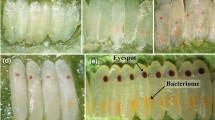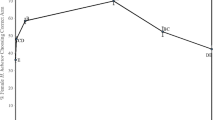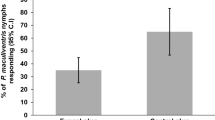Abstract
Venturia canescens (Gravenhorst) is an ichneumonid generalist parasitoid that successfully attacks the larvae of different lepidopteran pests that infest stored products. These pest species include Plodia interpunctella and Ephestia kuehniella. In this study, we aimed to evaluate the influence of the rearing host on the parasitoid’s ability to detect and respond to a new host different from the rearing species. For this reason, the trials tested the preference of parasitoids reared on P. interpunctella or E. kuehniella for products that were or were not infested with larvae of these hosts. The trials were conducted in a Y-tube olfactometer. Regardless of the rearing host species, the parasitoids showed no preference for uninfested products. The parasitoids were attracted to products infested with larvae of their rearing host in preference to uninfested products. They also showed preferential attraction to products infested with the new host over uninfested products. E. kuehniella was the preferred host, irrespectively of the parasitoid host rearing species. The results are discussed to develop a better understanding of the ecology of V. canescens for its application in biological control.
Similar content being viewed by others
References
Belda C, Riudavets J (2010) Attraction of the parasitoid Anisopteromalus calandrae (Howard) (Hymenoptera: Pteromalidae) to odors from grain and stored product pests in a Y-tube olfactometer. Biol Control 54:29–34
Belda C, Pons MJ, Gabarra R, Riudavets J (2008) Population dynamics of the natural enemies of stored product pests in cereal and dried fruit companies. Proc IOBC/WPRS 40:133–139
Bernstein C, Driessen G (1996) Patch-marking and optimal search patterns in the parasitoid Venturia canescens. J Anim Ecol 65:211–219
Bjorksten TA, Hoffmann AA (1995) Effects of pre-adult and adult experience on host acceptance in choice and no-choice tests in two strains of Trichogramma. Entomol Exp Appl 76:49–58
Corbet SA (1968) The influence of Ephestia kuehniella on the development of its parasite Nemeritis canescens. J Exp Biol 48:291–304
Corbet SA (1971) Mandibular gland secretion of larvae of the flour moth, Anagasta kuehniella, contains an epideictic pheromone and elicits oviposition movements in a hymenopteran parasite. Nature 232:481–484
Corbet SA (1973) Concentration effects and the response of Nemeritis canescens to a secretion of its host. J Insect Physiol 19:2119–2128
Desouhant E, Driessen G, Amat I, Bernstein C (2005) Host and food searching in a parasitic wasp Venturia canescens: a trade-off between current and future reproduction? Anim Behav 70:145–152
Dicke M, Sabelis MW, Takabayashi J, Bruin J, Posthumus MA (1990) Plant strategies of manipulating predator–prey interactions through allelochemicals: prospects for application in pest control. J Chem Ecol 16:3091–3118
Driessen G, Bernstein C, van Alphen JJM, Kacelnik A (1995) A count-down mechanism for host search in the parasitoid Venturia canescens. J Anim Ecol 64:117–125
Du YJ, Poppy GM, Powell W (1996) Relative importance of semiochemicals from first and second trophic levels in host foraging behaviour of Aphidius ervi. J Chem Ecol 22:1591–1605
Eliopoulos PA (2006) Life tables of Venturia canescens (Hymenoptera: Ichneumonidae) parasitizing the mediterranean flour moth (Lepidoptera: Pyralidae). J Econ Entomol 99:237–243
Eliopoulos PA, Stathas GJ (2005) Effects of temperature, host instar and adult feeding on progeny production by the endoparasitoid Venturia canescens (Gravenhorst) (Hymenoptera: Ichneumonidae). Environ Entomol 34:14–21
Eliopoulos PA, Harvey JA, Athanassiou C, Stathas GJ (2003) Effect of biotic and abiotic factors on reproductive parameters of the synovigenic endoparasitoid Venturia canescens. Physiol Entomol 29:268–275
Ellers J, van Alphen JM, Sevenster JG (1998) A field study of size-fitness relationships in the parasitoid Asobara tabida. J Anim Ecol 67:318–324
Guerrieri E, Pennacchio F, Ermenegildo T (1997) Effect of adult experience on in-flight orientation to plant and plant-host complex volatiles in Aphidius ervi Haliday (Hymenoptera: Braconidae). Biol Control 10:159–165
Ha DM, Choi SH, Shim JK, Jung DO, Song KS, Nho SK, Lee KY (2006) Behavioural attraction of two parasitoids, Venturia canescens and Bracon hebetor, to silk extracts of a host Plodia interpunctella. J Asia Pac Entomol 9:287–292
Harvey JA, Thompson DJ (1995a) Developmental interactions between the solitary endoparasitoid Venturia canescens (Hymenoptera: Ichneumonidae), and two of its hosts Plodia interpunctella and Corcyra cephalonica (Lepidoptera: Pyralidae). Eur J Entomol 92:427–435
Harvey JA, Thompson DJ (1995b) Host behaviour and its influence on foraging and acceptance by the solitary parasitoid wasp Venturia canescens (Hymenoptera: Ichneumonidae). Entomophaga 40:193–210
Harvey JA, Vet LEM (1997) Venturia canescens parasitizing Galleria mellonella and Anagasta kuehniella: differing suitability of two hosts with highly variable growth potential. Entomol Exp Appl 84:93–100
Harvey JA, Harvey IF, Thompson DJ (1994) Flexible larval growth allows use of a range of host sizes by a parasitoid wasp. Ecology 75:1420–1428
Harvey JA, Harvey IF, Thompson DJ (1995) The effect of host nutrition on growth and development of the parasitoid wasp Venturia canescens. Entomol Exp Appl 75:213–220
Harvey JA, Harvey IF, Thompson DJ (2001) Lifetime reproductive success in the solitary endoparasitoid, Venturia canescens. J Insect Behav 14:573–593
Heinlein G, Schöller M, Prozell S, Reichmuth C (2002) Oviposition of Venturia canescens (Gravenhorst) (Hymenoptera: Ichneumonidae) parasitizing the Indian meal moth Plodia interpunctella (Hübner) (Lepidoptera: Pyralidae). IOBC Bull/WPRS 25:109–114
Jembere B, Ngi-Song AJ, Overholt W (2003) Olfactory responses of Cotesia flavipes (Hymenoptera: Braconidae) to target and non-target Lepidoptera and their host plants. Biol Control 28:360–367
Lewis WJ, Martin WR (1990) Semiochemicals for use with parasitoids: status and future. J Chem Ecol 16:3067–3089
Lewis WJ, Vet LEM, Tumlinson JH, van Lenteren JC, Papaj DR (1990) Variations in parasitoid foraging behavior: essential element of a sound biological control theory. Environ Entomol 19:1183–1193
Meyhöfer R, Casas J (1999) Vibratory stimuli in host location by parasitic wasps. J Insect Physiol 45:967–971
Mudd A (1983) Further novel 2-Acylcyclohexane-1,3-doines from Lepidopteran larvae. J Chem Soc 1:2161–2164
Ozkan C (2007) Effect of food, light and host instar on the egg load of the synovigenic endoparasitoid Venturia canescens (Hymenoptera: Ichneumonidae). J Pest Sci 80:79–83
Ozkan C, Gokcek N, Tunca H (2004) Development time, fecundity and longevity of Venturia canescens (Gravenhorst) (Hymenoptera: Ichneumonidae) with Ephestia kuehniella Zeller (Lepidoptera: Pyralidae) as host. IOBC Bull/WPRS 27:173–175
Paust A, Reichmuth C, Büttner C, Prozell S, Adler CS, Schöller M (2006) Spatial effects on competition between the larval parasitoids Habrobracon hebetor (Say) (Hymenoptera: Braconidae) and Venturia canescens (Gravenhorst) (Hymenoptera: Ichneumonidae) parasitising the Mediterranean flour moth, Ephestia kuehniella. In: Proceedings of the 9th international working conference on stored product protection, Campinas, São Paulo, Brazil. Brazilian Post-harvest Association-ABRAPOS, Passo Fundo, pp 797–803
Rahman MM, Roberts HLS, Schmidt O (2007) Factors affecting growth in the koinobiont endoparasitoid Venturia canescens in the flour moth Ephestia kuehniella. J Insect Physiol 53:463–467
Sahin AK, Ozkan C (2007) Effect of light on the longevity and fecundity of Venturia canescens (Gravenhorst) (Hymenoptera: Ichneumonidae). Pak J Zool 39:315–319
Sait SM, Begon M, Thompson DJ, Harvey JA, Hails RS (1997) Factors affecting host selection in an insect host–parasitoid interaction. Ecol Entomol 22:225–230
Salt G (1975) The fate of an internal parasitoid, Nemeritis canescens, in a variety of insects. Trans Royal Entomol Soc Lond 127:141–161
SAS Institute (2002) Enterprise guide v2.0. SAS Institute, Cary, USA
Steidle JLM, Schöller M (2002) Fecundity and ability of the parasitoid Lariophagus distinguendus (Hymenoptera: Pteromalidae) to find larvae of the granary weevil Sitophilus granarius (Coleoptera: Curculionidae) in bulk grain. J Stored Product Res 38:43–53
Trematerra P, Fontana F, Mancini M, Sciarretta A (1999) Influence of intact and damaged cereal kernels on the behaviour of the rice weevil, Sitophilus oryzae (L.) (Coleoptera: Curculionidae). J Stored Prod Res 35:265–276
Trematerra P, Sciarreta A, Tamasi E (2000) Behavioral responses of Oryzaephilus surinamensis, Tribolium castaneum, Tribolium confusum to naturally and artificially damaged durum wheat kernels. Entomol Exp Appl 94:195–200
Thiel A, Driessen G, Hoffmeister TS (2006) Different habitats, different habits? Response to foraging information in the parastic wasp Venturia canesces. Behav Ecol Sociobiol 59:614–623
Thorpe WH, Jones FGW (1937) Olfactory conditioning in a parasitic insect and its relation to the problem of host selection. Proc Royal Soc Lond 124:56–81
Turlings TCJ, Scheepmaker JWA, Vet LEM, Tumlinson JH, Lewis WJ (1990) How contact foraging experiences affect preferences for host-related odors in the larval parasitoid Cotesia marginiventris (Cresson) (Hymenoptera: Braconidae). J Chem Ecol 16:1577–1589
Turlings TCJ, Tumlinson JH, Heath RR, Proveaux AT, Doolittle RE (1991) Isolation and identification of allelochemicals that attract the larval parasitoid Cotesia marginiventris (Cresson), to the microhabitat of one of its hosts. J Chem Ecol 17:2235–2251
Turlings TCJ, Wäkers FL, Vet LEM, Lewis WJ, Tumlinson JH (1993) Learning of host-finding cues by hymenopterous parasitoids. In: Papaj DR, Lewis AC (eds) Insect learning, Ecological and evolutionary perspectives. Chapman and Hall, New York, USA, pp 51–78
Vet LEM, Dicke M (1992) Ecology of infochemical use by natural enemies in a tritrophic context. Annu Rev Entomol 37:141–172
Vet LEM, Groenewold AW (1990) Semiochemicals and learning in parasitoids. J Chem Ecol 16:3119–3135
Vet LEM, Lewis WJ, Cardé RT (1995) Parasitoid foraging and learning. In: Cardé RT, Bell WJ (eds) Chemical ecology of insects, 2nd edn. Chapman & Hall, New York, USA, pp 65–101
Villagra CA, Pennachio F, Niemeyer HN (2007) The effect of larval and early adult experience on behavioral plasticity of the aphid parasitoid Aphidius ervi (Hymenoptera, Braconidae, Aphidiinae). Naturwissenschaften 94:903–910
Vinson SB (1976) Host selection by insect parasitoids. Annu Rev Entomol 21:109–113
Acknowledgments
We would like to thank Miss Silvia Rascón for rearing all the colonies and for her help in the trials and also to Miss Carolina Jimenez. Special thanks to Dr. Jordi Comas Angelet for his help in the statistical analysis. This work was supported by grants from the “Instituto Nacional de Investigación Agraria y Alimentaria, Subprograma Nacional de Recursos y Tecnologías Agrarias en Cooperación con las Comunidades Autónomas” “INIA RTA 2008-00002-CO2-01 (FEDER)” and “INIA RTA 2011-00025-CO2-01 (FEDER)”; and by grant number 64 from the “Programa de Becas Predoctorales para la formación de personal investigador” of the “Instituto Nacional de Investigación Agraria y Alimentaria (INIA)”, which was awarded to the first author.
Author information
Authors and Affiliations
Corresponding author
Additional information
Handling Editor: Stefano Colazza
Rights and permissions
About this article
Cite this article
Belda, C., Riudavets, J. The influence of the rearing host on the response of the parasitoid Venturia canescens (Gravenhorst) (Hymenoptera: Ichneumonidae) to odours from Ephestia kuehniella and Plodia interpunctella in a Y-tube olfactometer. BioControl 57, 801–808 (2012). https://doi.org/10.1007/s10526-012-9461-3
Received:
Accepted:
Published:
Issue Date:
DOI: https://doi.org/10.1007/s10526-012-9461-3




